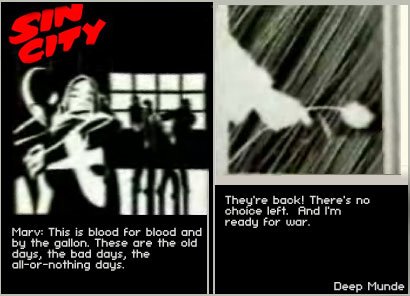"Does the neo-noir genre continue to follow the representations of the classic film noir genre, with particular reference to ‘Sin City’ (2005)"
Media Language: A black and white effect to coincide with the film noir genre. Low-key lighting creates dramatic emotion within the scene.
Institution: Dimension Films a sub company of Miramax previously under Walt Disney produced this film with a large budget run by the Weinstein brothers who used this label to produce and distribute genre films, similarly ‘Kill Bill’ which is also a hybrid of Hollywood and Art-house film.
Genre: Neo-noir is incorporating aspects of film noir into newer contemporary films. Unlike classic noirs, neo-noir films are aware of modern circumstances and technology
Representation: The representation of men shows a patriarchal society, as all three protagonists are male. They dominate women throughout the film, where no female subverts stereotypes; women need men to save the day.
Audience: ‘Sin City’ appeals to a male audience who can identify with the male protagonist. The females within the film also appeal to the male audience and conform to the male gaze.
Ideology: Goes along with today’s idea of society, women are weaker then men and need them to save the day.
Narrative: The film subverts the typical Todorvian narrative structure. Three stories intertwine with one another; this makes the film more art-house rather than a mainstream genre film. ‘The Big Fat Kill’ shows the most female representation within ‘Sin City’, whereas the other two sub narratives have male protagonists.
--------------------------------
Social Context: Represents binge drinking and prostitution in a negative manner.
Historical: Film Noir films are stylish Hollywood crime dramas; particularly emphasize moral uncertainty and sexual motivation.
Economical: Large budget, similar to other Hollywood films.
Political:
--------------------------------
The Big Combo (1955), USA, directed by Joseph H. Lewis
Blade Runner (1982), USA, Ridley Scott
Pulp Fiction (1994), USA, Quentin Tarantino
Reservoir Dogs (1992), USA, Quentin Tarantino
--------------------------------
Todorov: Sin City doesn’t follow Todorov’s theory. It has three different narratives, none of which are linear.
Laura Mulvey: Her theory can be easily applied as the prostitutes within the film comply with the idea of women being there to be looked at. Additionally, the idea of the male gaze is ever present throughout the film.
Propp: There is no specific characters role within the film as a whole, although singular narratives do comply with Propp’s character theory.
Barthes: The non-linear narrative means immediately the audience are drawn into an enigma. The beginning also gives away an enigma to the audience as someone is murdered, but the audience have no idea who or why this is happened.

1 comment:
Would you not consider the prostitutes' in Dwights story, to infact be stronger characters over all. They can take care of them selves (yes Dwight initially saves them), as they stand against the intruders and fight them all off.
I agree with the fact that they are constructed to conform visually to the the male gaze, and the male characters are an adequate ego for male viwers to project them selves onto and fantisize about interaction with the women.
I would consider this scene, personally, to portray a fairly strong female role within modern cinema.
Im not sure that the entire movie goes along with the "women are weaker then men and need them to save the day" idea, as one of these women is originally a child, who turns out to be Hartigans only reason for living through the prison hell, Mickey Rourkes characters story is one of revenge. I would consider the only "weak" female in this story to be that of Dwights girlfriend.
What are your thoughts to this? I welcome your reply.
Post a Comment